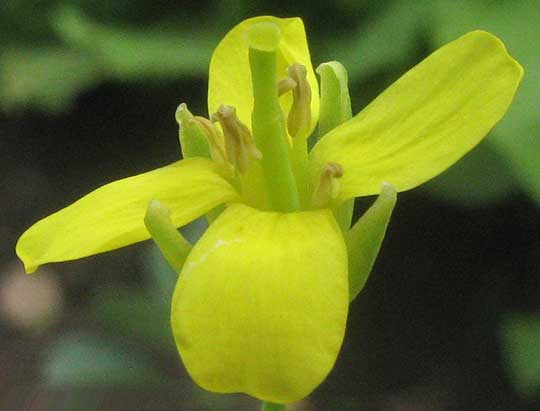Excerpts from Jim Conrad's
Naturalist Newsletter

from the the October 28, 2012 Newsletter issued from the valley of the Dry Frio River in northern Uvalde County, southwestern Texas, on the southern border of the Edwards Plateau; elevation ~1750m (~5750 ft); N29.62°, W99.86°; USA
BOK CHOY/ PAK CHOI, ETC.
I suspect that the main reason this week we've experienced sudden outbreaks of both Cactus Bugs and Crucifer Flea Beetles is because so far this fall it's been unusually hot -- into the upper 80s and lower 90s all week. Probably that's also the reason many of my Mustard Family plantings have "bolted" -- begun flowering when I'd much rather they use their photosynthesized carbohydrate to make succulent leaves for me to eat. You can see a bolting Bok Choy plant above.
Actually, it's kind of nice seeing the fresh, springy yellowness of these mustard flowers in October, a sort of preview of the upcoming spring. You can just feel the springiness in the flower close-up below:

This blossom shows a typical Mustard Family blossom with its four petals forming the cross, or "crux" of "Crucifereae," the old name for the Mustard Family. And framed by those four petals are six stamens, four long and two short ones, exactly as the family requires. That 4+2 stamen configuration technically is said to be "tetradynamous."
The preponderance of members of the Mustard Family in my Texas winter garden is even more interesting when you realize that just one genus of that family produces a large percentage of cultivars -- the "coles" or mustards. It's the genus Brassica.
The Mustard Family, the Brassicaceae, contains over 330 genera and about 3,700 species, and Brassica isn't even one of the very largest genera, including only about 30 wild species. However, within that genus Brassica you find whole rainbows of species and varieties and strains that are important crops, and often are very dissimilar in appearance even when they are extremely closely related. For example, among the cultivars of Brassica napus are rutabaga, canola and rapeseed. The single species Brassica oleracea produces cabbage, kale, broccoli, cauliflower, Brussels sprouts and kohlrabi. Brassica rapa gives us turnips, Chinese cabbage, and various oriental plants most of us have never heard of, but which are wonderful creations, such as rapini and komatsuna.
My bolting Bok Choy can be considered a kind of Chinese cabbage. And the world of Chinese cabbage is a large, diverse and confusing one, one in which English speaking Westerners haven't yet settled on the names and concepts of things. Some people say Bok Choy is the same as Pak Choi, and others swear they're different things. Then there are many traditional, named cultivars of Bok Choy, such as Hanakan, Mei Qing Choi, Red Tatsoi, etc.
What a wonderful thing is this Mustard Family, and this genus Brassica, and how I'm looking forward to planting, growing and digesting as many variations on the Mustard Family and Brassica themes as I can... if I can just get my Crucifer Flea Beetles under control.